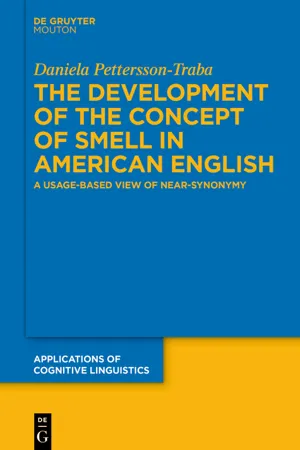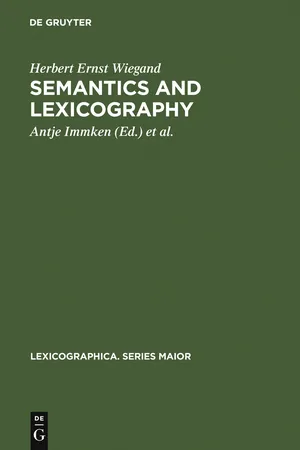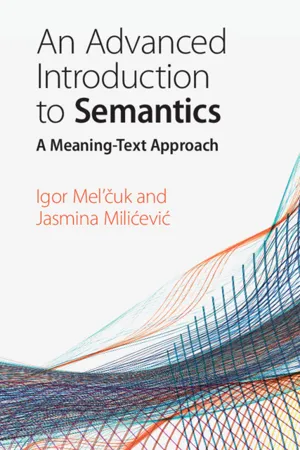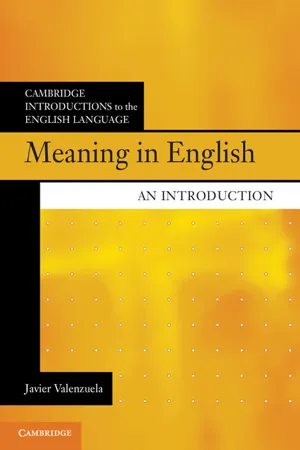Languages & Linguistics
Synonymy
Synonymy refers to the relationship between words that have similar meanings. In linguistics, it is the phenomenon where two or more words have equivalent or nearly equivalent meanings. Synonyms are important for understanding language diversity and the nuances of meaning within different languages.
Written by Perlego with AI-assistance
6 Key excerpts on "Synonymy"
- eBook - ePub
The Development of the Concept of SMELL in American English
A Usage-Based View of Near-Synonymy
- Daniela Pettersson-Traba(Author)
- 2022(Publication Date)
- De Gruyter Mouton(Publisher)
2 SynonymyIn the introductory chapter Synonymy was defined as a relation of identity of meaning between two or more words or word senses. However, it was claimed that a less strict definition is more suitable for this semantic relation, as words are rarely – if ever – completely identical in meaning. In fact, different types of synonyms can be distinguished depending on which aspects of meaning they share, i.e., whether they match only in denotative meaning or whether they coincide also in other dimensions, such as connotation, style, and/or collocation (cf. Section 2.1 below). This implies that different degrees of Synonymy exist, and it appears to be the case that competent language users have an intuition about some words or word senses being more synonymous than others (e.g., Lyons 1968 : 447; Cruse 1986 : 265–268). Even within a specific set of synonyms, speakers commonly have the feeling that some members of a synonym set share more semantic features than others and can thus be interchanged in more contexts of use. However, although Synonymy is typically defined and viewed as a semantic relation of similarity, it is also crucial to consider the differences between synonymous words in order to provide a comprehensive picture of the semantic relation that holds between them. This is so because, as has already been pointed out, a great majority of synonyms, despite being semantically similar in one or more aspects, also differ in other respects, which prevents them from being freely interchangeable when used.Once the focus shifts from concentrating solely on the similarities to considering also the level of contrast between synonymous words, it becomes evident that the way in which synonyms differ from each other varies from synonym set to synonym set, as well as from synonym to synonym. Edmonds (1999 : Chapter 3) claims that there are at least 35 ways in which synonyms can differ and provides evidence of the complex and intriguing nature of Synonymy. In fact, research on Synonymy has been and continues to be a rich field of study in many areas of linguistics, including lexicography (e.g., Atkins and Levin 1995 ; Bergenholtz and Gouws 2012 ; Murphy 2013 ), computational linguistics (e.g., Edmonds 1999 ; Edmonds and Hirst 2002 ; Inkpen and Hirst 2006 ), and language learning and teaching (e.g., Martin 1984 ; Xiao and McEnery 2006; Liu and Zong 2016 - eBook - PDF
Semantics and Lexicography
Selected Studies (1976-1996)
- Herbert Ernst Wiegand, Antje Immken, Werner Wolski, Antje Immken(Authors)
- 2011(Publication Date)
- De Gruyter(Publisher)
Some of these concepts are also important when trying to discuss a concept of Synonymy for monolingual lexicography within the framework of the questions raised here. 26 Synonymy understood as a theoretical concept leads to at least the following two conclu-sions : (1) Claiming Synonymy in the form of X is synonymous to (here and subsequently and are variables for expressions of only one language L) can only be discussed adequately if taken relative to a specific theoreti-cal concept of Synonymy that is more than a mere linguistic label for a random list of expressions of a lan-guage L which are a priori regarded as being synonymous. (2) Synonyms and their Synonymy or synonymity 27 , in the sense of any theory, are not simply given to us as language phenomena; they do not simply reveal their characteristic of being synonymous in everyday com-munication. However, speakers who know or are competent in a language L experience in and through communication that numerous expressions of L are frequently used in a similar or identical way. Examples are: fast/beinahe (almost/nearly), obschonlobgleich (even thought although), Schimmel/weißes Pferd (white horse/white horse), Resultat/Ergebnis (result/outcome), ledig/unverheiratet/alleinstehend (unmarriedlun-marnedlsingle), AufzuglFahrstuhllLift (liftlelevatorllift), Dusche/Brause (shower/shower), Hast/Eile (hurry/ rush), Schluß/Ende (conclusion/end), da/don (there/there), Apfelsine/Orange (orange/orange), Adresse/An-schrift (address/address), beginnen/anfangen (to begin/to start), FußballlLeder (football'football), Morgen-landlOrient (Orient/East) etc. - eBook - PDF
An Advanced Introduction to Semantics
A Meaning-Text Approach
- Igor Mel'čuk, Jasmina Milićević(Authors)
- 2020(Publication Date)
- Cambridge University Press(Publisher)
To that effect, Meaning-Text theory has proposed the for- malism of lexical functions: a cross-linguistically valid descriptive tool able to account for all types of lexical relations in a systematic way. Paradigmatic lexical relations are presented in Section 1, and syntagmatic relations, in Section 2; lexical functions are dealt with in the next chapter. 1 Paradigmatic Lexical Relations This section deals with the core semantic-lexical relations of Synonymy, antonymy and conversion (1.1), the relation of derivation in a broad sense (1.2), as well as the relation of equinomy, which manifests itself in the lexicon as polysemy and homonymy (1.3). 1.1 The Core Paradigmatic Lexical Relations: Synonymy, Antonymy, Conversion Synonymy, antonymy and conversion are the most salient lexical relations; they are the first to have been discovered and studied in linguistics. 1.1.1 Synonymy Definition 6.1: (Exact) Synonymy Two LUs L 1 and L 2 stand in the relation of exact Synonymy and are called exact synonyms [Syn], iff the following four conditions are simultaneously satisfied: 1. The meanings of L 1 and L 2 – that is, their signifieds – are identical: ‘L 1 ’ = ‘L 2 ’. 2. The signifiers of L 1 and L 2 are different. 3. L 1 and L 2 belong to the same part of speech. 4. If L 1 and L 2 have semantic and deep-syntactic actants, the actants i, j, k, … of the one correspond one-to-one to the actants i, j, k, … of the other. For example, the lexemes DRUNK and INTOXICATED, as in The driver stopped in Denville was drunk 〈≡ intoxicated〉, are exact synonyms, since their signifiers are different, while their meanings, parts of speech and actantial 6 Lexical Relations 143 structures are identical: both are adjectives meaning ‘[person X] unable to control X’s behavior because X has drunk too much alcohol’. This is true also of the nouns COUGAR and ˹ MOUNTAIN LION˺, whose meanings are also identical: ‘a large brown wild cat living in the mountains’. - eBook - PDF
Historical Dictionaries and Historical Dictionary Research
Papers from the International Conference on Historical Lexicography and Lexicology, at the University of Leicester, 2002
- Julie Coleman, Anne McDermott, Julie Coleman, Anne McDermott(Authors)
- 2012(Publication Date)
- De Gruyter(Publisher)
Eric Stanley, Pembroke College, Oxford POLYSEMY AND Synonymy AND HOW THESE CONCEPTS WERE UNDERSTOOD FROM THE EIGHTEENTH CENTURY ONWARDS IN TREATISES, AND APPLIED IN DICTIONARIES OF ENGLISH Words may be 'esteemed synonymous'; but are they? Linguistic theory and philosophy of the twentieth century used the concept 'Synonymy' in a sense wider than that in less specialized use. This narrower sense, that is, 'Synonymy of terms', is fundamentally analysed and discussed by Quine (1960: 51-7, § 12 of Quine's book). When considered in relation to two or several languages it may be used to demonstrate the indeterminacy of translation. Even within a single language, words that pass for synonyms are usually not wholly equipollent. This was well understood by the Abbé Girard (1718), the very title of whose book refers not simply to 'synonyms' but to les différentes significations des mots qui passent pour synonimes} This wording is adapted by John Trusler (1766) in his title as words esteemed synonymous in the English language. He followed Girard in indicating the subjectiveness and relativity of Synonymy, based on the fact that so-called synonyms are coterminous only for some part of their polysemous range. Mrs Piozzi's dilettante Synonymy; George Crabb, though aware of foreign synonymies, produces a Synonymy that is not much better At the beginning of the nineteenth century, George Crabb's analysis of Synonymy in English opens the brief preface to his English Synonymes Explained with a statement of contempt for earlier, more amateurish English endeavours (Crabb 1816: p. [i]): Wartburg (1922-: VII, fascicle 50, 709-10) does not record passer pour 'avoir la réputation de' before 1640, perhaps correctly; yet it seems probable that the English idiom to pass for was calqued on the French idiom. It comes in The Merchant of Venice I.ii.61 (Shakespeare 1623: Comedies 163 = sig. [05 ro ]; Hinman 1968: 183), the earliest quotation given for subsense 5.a.: NerfissaJ. - eBook - PDF
Meaning in English
An Introduction
- Javier Valenzuela(Author)
- 2017(Publication Date)
- Cambridge University Press(Publisher)
Another example that comes to mind is the word paper, which has many different related meanings (writing material, sheet of paper, newspaper, a scholarly Chapter 5, section [5.2] 120 essay, an oral presentation, etc.), but some of them are not so easy to predict, as they are rather ‘idiosyncratic’ extensions. On the other hand, sometimes a given polysemous sense becomes very conventional and is stored separately: people learn that extension and keep it in mind. This can explain why we keep polysemous senses that originated a long time ago. For example, iron is a metal; this material was used in the devices used to take out the wrinkles of clothing, and thus the extension material > object: nowadays irons are not made of iron, but still, we have these two senses associated with the word iron. Thus, depending on the case, polysemy and homo- nymy can function in the same way. 5.3 Semantic Relations 5.3.1 Synonymy Sometimes two different words may have a very similar meaning. Such is the case of car and automobile, for example. When two words or expres- sions have the same meaning, they are called synonyms. In the opinion of many authors, though, total Synonymy does not exist: that is, no two words or expressions have exactly the same meaning. In a way, total Synonymy would make less sense in terms of storage. If we have one meaning A associated with form X, why bother learning another form Y for exactly the same meaning? So, what we find normally is near- synonyms or partial-synonyms; synonyms that are different in some small aspect, either in formality (register), or in syntagmatic relations, or that offer some different nuance of meaning. Take the example of quick and fast. They look very similar, but it is easy to find a difference. Take the examples in (2): (2) a. a fast walk b. a quick walk (2a) would describe a walk that proceeds at a quick pace, walking quickly, and (2b) would correspond to a walk that takes a short time to complete (even if you walk slowly). - eBook - PDF
- Paul L. Garvin(Author)
- 2018(Publication Date)
- De Gruyter Mouton(Publisher)
This trend is dealt with in § 3.2 below. Since the critical study of Synonymy in a disciplined lexicological framework is thus still in its beginnings, the investigation of specialized synonym relationships of the submeanings of a polysemous word cannot be expected to be far advanced. V. V. Vinogradov has given a number of instructive examples of this phenonmenon: he has shown, for example, that oblec' in its literal meaning, 'to clothe', is a bookish-solemn synonym of odet', whereas in its derivative meanings (e.g. the phraseologically bound oblec' tajnoj 'to envelop in mystery', oblec' doverierri to bestow confidence on', etc.) it has no synonymic relations with odet' . A. D. Grigor'eva has devoted some attention to cases of Synonymy among derived word meanings where the basic, des-ignative meanings of the corresponding words are not synonymous (e.g. gluxaja tisina 'deaf silence' = nemaja tisina 'mute silence') and has considered the phraseo-logical specialization of words which, free of context, appear synonymous. 41 But all these comments are programmatic and anecdotal. 3.2 Syntactic Characterization of Words The fundamental papers in Soviet lexicology (cf. footnotes 19 and 20) already called attention to the fact that a polysemous word may have differential syntactic properties depending on the submeaning in which it is used. V. V. Vinogradov, for example, showed that animal names when used as expressive terms for character traits ( gus' 'goose', lisa 'vixen', etc.), unlike the same nouns in their plain designative function, are virtually restricted to the predicate. In another set of illustrations, igrat' 'to play (at...)' was shown to govern the preposition v plus accusative, while igrat' 'to play (on...)' governs na plus locative. Similarly, otozvat' sja 'to respond (to)' takes na + acc., while otozvat'sja 'to affect' takes na + locative.
Index pages curate the most relevant extracts from our library of academic textbooks. They’ve been created using an in-house natural language model (NLM), each adding context and meaning to key research topics.





